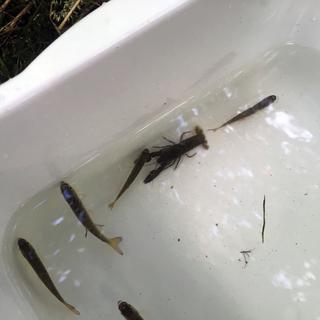Did you know that there is a five acre farm in the middle of Harewood? This farm is actually one of the last historical five acre farm parcels left in Nanaimo, therefore, there is a lot of interest to protect it. In order to do this, we have to assess the ecological value of the farm and the watershed in and around the area. More specifically, there is a “no name” tributary that flows into and drains out of a wetland, located on the farm property, and then flows down into the Chase River. After speaking with local residents, we learned that there were observations years ago of fish using this stream of water that runs through the farm. Therefore, we wanted to investigate if this stream currently provides suitable fish habitat and if we can observe fish in the tributary.
On July 3rd, a team of us, accompanied by Dr. John Morgan, went to the stream to set 5 minnow traps in order to see if this stream is currently able to support juvenile fish. We started by placing them in the lowest part of the stream that we had mapped and then worked our way up. Two traps were placed below the wetland of the farm, two were placed in the wetland, and one was placed in the uppermost part of the stream that we were able to locate and access. It was predicted that fish would most likely be found in the minnow traps placed at the lowest part of the mapped tributary. This was due to our observations of less vegetation and trees impeding the flow of water in these areas, which should support fish migration into the Chase River. On the other hand, the water in the uppermost part of the stream was stagnant, muddy, and most likely anoxic. When we were placing a minnow trap at this location, we could smell hydrogen sulfide surfacing as we walked through the muddy waters.
The next morning, on July 4th, we returned to the stream to retrieve the traps that we had set. We were really excited and curious to see if our traps were able to catch anything. We got to the first trap and observed juvenile rainbow trout (Oncorhynchus mykiss)! When we got to the second trap, we saw a handful of juvenile coho salmon (Oncorhynchus kisutch), another rainbow trout, and a single crayfish (Pacifastacus leniusculus). The next two minnow traps that were set in the wetland only had a couple of large beetles, the species of which we were unable to unidentify at the time. Finally, there was nothing in the last minnow trap that was placed at the top of the tributary, as expected.
Although fish were not observed in all five of our traps, our observations were extremely exciting and we were happy to learn that rainbow trout and coho salmon were using portions of the stream as habitat. We will be moving forward and placing new minnow traps at different locations of the stream, hopefully this week (July 9th-13th). The detection of juvenile fish in the tributary could potentially assist with the initiative to restore more fish habitat in the area and to protect one of the last five acre farm parcels in Nanaimo.


